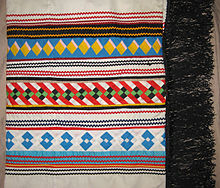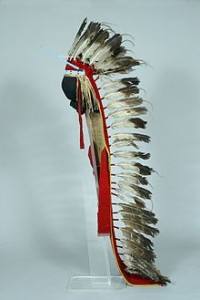 The use of Native American textiles dates back to between seven-thousand and eight-thousand years ago. Pieces of fabric used to wrap bodies for burials have been found at the Windover Archaeological Site located in Florida. In all, a total of 87 pieces of fabric were discovered at the site, and seven different weaves existed in the fabric. The Wheelwright Museum of the American Indian was founded in 1937 in part to honor Native American textiles. Located in New Mexico, the museum features Navajo art and culture pieces utilizing Native American textiles from 1850 to the present day.
The use of Native American textiles dates back to between seven-thousand and eight-thousand years ago. Pieces of fabric used to wrap bodies for burials have been found at the Windover Archaeological Site located in Florida. In all, a total of 87 pieces of fabric were discovered at the site, and seven different weaves existed in the fabric. The Wheelwright Museum of the American Indian was founded in 1937 in part to honor Native American textiles. Located in New Mexico, the museum features Navajo art and culture pieces utilizing Native American textiles from 1850 to the present day.
Native American Textiles
Native American textiles have been used to create works of art that continue to be wildly popular today. Different tribes used and continue to use different methods to create beautiful rugs using Native American textiles. The designs of these and other rugs are once again dependent upon the traditions of tribes. Native American textiles are also currently used to make blankets, sashes and ribbons.
Native American Textiles: Headdresses
 A Native American headdress is one of the most distinguishable uses of Native American textiles. A feather war bonnet is perhaps the most commonly seen form of a Native American headdress. The bonnets were worn only by a handful of tribes in the Great Plains region. The headdresses were made from the tail feathers of golden eagles and each feather represented an act of bravery.
A Native American headdress is one of the most distinguishable uses of Native American textiles. A feather war bonnet is perhaps the most commonly seen form of a Native American headdress. The bonnets were worn only by a handful of tribes in the Great Plains region. The headdresses were made from the tail feathers of golden eagles and each feather represented an act of bravery.
The most frequently used type of Native American headdress is the roach headdress. The hair from a porcupine, moose or deer’s tail was commonly used to create these headdresses. They were worn by male dancers and warriors. Other types of Native American headdresses include basket hats, feather headbands and buffalo headdresses.